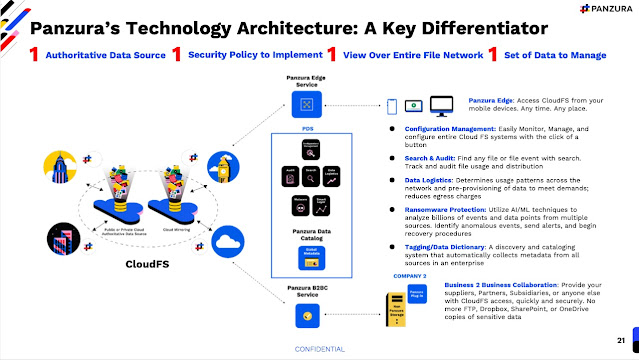Besides a strong and comprehensive technology, Panzura, recognized as a pioneer, had real difficulties to take off except with some key deals in some industries for specific use cases.
The product known today as a cloud file storage was initially categorized as a cloud gateway and had several names. The current team positions the product as a hybrid multicloud data management leveraging its cloud file system layer coupled with data services and SmartApps. The company got acquired 2.5 years ago for a bargain by Profile Capital Management and Jill Stelfox and Dan Waldschmidt led the company since that episode. Congrats to Jill and Dan to have identified a real gold mine. So far the company has raised a total of $170 million with a recent $80 million Series B round last May.
Under this period of operations, Panzura shows an impressive growth of 485% and more than 500 customers, a growth that is still a dream for some of its direct competitor. The company has retained 98% of the customers from the old Panzura. The mission changed a bit or let’s say was rephrased to target today security, visibility and control of the enterprise data.

Let’s summarize what Panzura offers today. First, our readers must understand that Panzura is a data access solution for unstructured data, the product doesn’t store anything but delivers ubiquitous instances to expose content via industry standard file sharing protocols such NFS and SMB. As a key simple message, to deploy Panzura users just need an object storage for data residence and a Panzura VM instance or subscribe to an in-cloud instance.
The first layer CloudFS operating as a global cloud file system exposes a single consistent view of data. Panzura solves the data integrity or divergence challenge and offers a single file system image across sites, globally. Users feel data are local as Panzura instances cache data to offer similar experience as classic local data with file servers or NAS. Data are deduped and compressed to reduce footprint, transfer size and increase security. This layer relies on S3 object storage services that could be deployed on-premises or exposed by public cloud providers. The company implements an advanced snapshot mechanism leveraging the immutability of the object storage backend. This fundamental layer can run on-premises but also in the cloud as the product is available on the marketplace of Azure, GCP and AWS. Today CloudFS is the 8th generation.

On top of CloudFS, Panzura Data Services offer a rich range of functions around analytics and governance. I understand that Vizion.AI, the external service that relies on elasticsearch has been repatriated from AWS but still offers a SaaS experience. This service implements some AI engine to boost search capabilities and monitors all file operations.
And lastly, SmartApps, the last upper layer, with different modules such edge access, company connect and ransomware alerts leveraging data services and cloudFS. The company plans to offer some content search capabilities in the future.

In terms of pricing, it is based on the capacity managed by CloudFS and then per user for data services and SmartApps. There is no price per node.
As I introduced several years ago the notion of U3 storage for Universal, Unified and Ubiquitous, we can qualify Panzura of an U3 solution. Coldago Research will publish in a few weeks its U3 index with several vendors from classic to emergent and several new ones.
The battle against CTera Networks and Nasuni will be interesting to watch in the coming quarters.




















0 commentaires:
Post a Comment